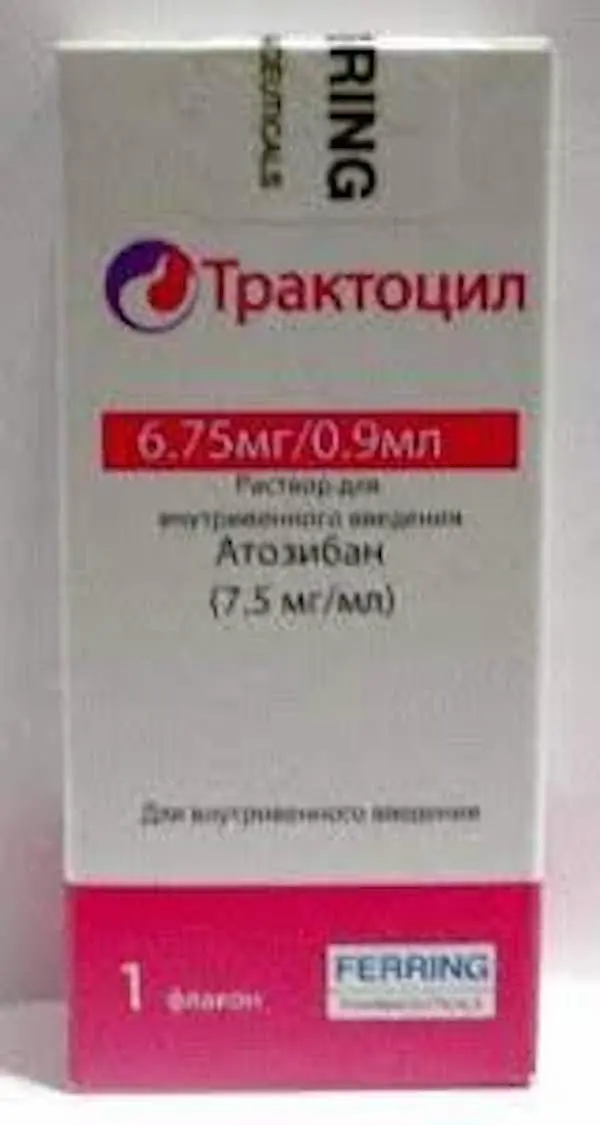Description
Tractocil Pharmacodynamics
Tractocil contains atoziban, a synthetic peptide ([Mra1, D-Tyr(Et)2, Thr4, Oxx]-oxytocin). Binding to human oxytocin receptors, atoziban is a competitive antagonist of human oxytocin. In preclinical studies, it was shown that atoziban, interacting with oxytocin receptors, reduces the frequency of uterine contractions and myometrial tone, which leads to suppression of uterine contractility. Atoziban also binds to vasopressin receptors, inhibiting the effect of the latter. Preclinical studies showed no signs of atoziban effect on the cardiovascular system.
In the case of preterm labor in a woman, atoziban inhibits uterine contractions at recommended doses and provides functional peace to the uterus. Uterine relaxation after administering atoziban is achieved quickly, within 10 minutes myometrial contractile activity is significantly reduced, maintaining a stable functional uterine rest (< 4 contractions per hour) for 12 hours.
Clinical Studies
A Phase III clinical trial (CAP-001) enrolled 742 women with preterm labor at 23-33 weeks’ gestation. Patients were randomized into 2 groups and received atoziban or (3-adrenomimetics (dosage was titrated) to reduce labor.
The primary endpoint was the proportion of women with stopped preterm labor that did not require additional tocologic medication within 7 days of the start of treatment.
Secondary endpoint is the number of women in whom preterm labor was stopped within 48 hours of treatment initiation.
The mean gestational age at the time of delivery was 35.6±3.9 and 35.3±4.2 weeks for women who used atoziban and p-adrenomimetics, respectively (p=0.37). The study showed that 59.6% (n=201) and 47.7% (n=163) of pregnant women who used atoziban and p-adrenomimetics (p=0.0004), respectively, stopped preterm labor and did not require the administration of alternative tocolytics. Most of the negative results of atoziban use were due to poor tolerability. The incidence of poor efficacy due to poor tolerance (p=0.0003) was higher in the atoziban group (n=48, 14.2%) than in the p-adrenomimetic group (n=20, 5.8%).
This study showed that the likelihood of achieving the primary endpoint (stopping preterm birth and not requiring alternative tocolytics within 7 days of treatment initiation) was comparable in patients at 24-28 weeks’ gestation who received atoziban or p-adrenomimetics. It should also be noted that the conclusion was based on data from a small sample (n=129 patients).
In terms of achieving the secondary endpoint, the efficacy of atoziban was comparable to that of p-adrenomimetics.
The number of neonates admitted to the intensive care unit was similar (approximately 30%), as was the length of stay on ventilator. The mean newborn weight was 2491 ±813 g in the atoziban group and 2461 ±831 g in the p-adrenomimetics group (p=0.58). The obtained data on the health status of patients and newborns were similar in both groups. However, based on the available data, the presence of differences in the drugs cannot be ruled out.
Of the 361 patients who received atoziban in the phase III clinical trial, 73 pregnant women received 1 repeat course of treatment, 8 women received 2 repeat courses, and 2 women received 3 repeat courses.
In the placebo-controlled clinical trial, the perinatal mortality rate was 5/295 (1.7%) in the placebo group and 15/288 (5.2%) in the atoziban group, including 2 documented fetal deaths at 5 and 8 months of age. Eleven fetal deaths in the atoziban group were recorded at 20-24 weeks’ gestation. It was noted that the distribution of subjects in the 20-24 week gestation subgroup between the drug application groups (atoziban group – 19 patients, placebo group – 4 patients) was uneven. In the subgroup of pregnant women with gestational age greater than 24 weeks, the rate of perinatal mortality was comparable for both drug groups (1.7% in the placebo group, 1.5% in the atoziban group).
The safety and efficacy of atoziban in women with gestational age less than 24 weeks has not been evaluated in controlled randomized trials.
- Therapy with Tractocil should be prescribed and carried out by a qualified physician experienced in preterm birth.
- Tractocil is administered intravenously, immediately after the diagnosis of preterm labor, in 3 consecutive steps:
- The total duration of treatment should not exceed 48 h. The maximum dose of Tractocil for the entire course of treatment should not exceed 330.75 mg atoziban. Intravenous single-stage administration of the drug should be carried out immediately after the diagnosis of preterm labor. After bolus injection, intravenous infusion (prepared from concentrate for preparation of infusion solution containing atoziban 37.5 mg/5 ml) should be started. If uterine contractility remains unchanged during therapy with Tractocil, alternative treatment should be considered.
- The table provides a full description of the dosing regimen for bolus administration and subsequent infusion:
- Stage Mode Injection/infusion rate Atoziban dose
- Continuous infusion
- Continuous infusion for up to 45 hours
- Repeated use
- If repeated administration of atoziban becomes necessary, it should also be started with a bolus infusion of 6.75 mg/0.9 mL intravenous solution (Step 1), followed by an infusion of 37.5 mg/5 mL infusion concentrate to prepare the infusion solution (Steps 2 and 3).
- Patients with impaired hepatic and/or renal function
- There are no data on the use of the drug in patients with hepatic or renal dysfunction.
- Renal dysfunction does not require dose modification because very little atoziban is excreted by the kidneys.
- Caution should be exercised when using atoziban in patients with hepatic impairment.
- Directions for the administration of the drug (phase I):
- Before administering the solution, vials should be visually inspected for undissolved particles and discoloration of the solution.
- Preparation of the initial solution for intravenous administration:
- Draw 0.9 mL of Tractocil, IV solution from the vial and administer intravenously slowly over 1 min under the close supervision of a physician in the obstetrics department.
- The injections should be used immediately after opening the vial.





